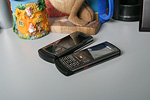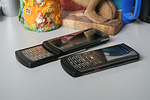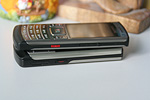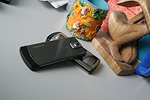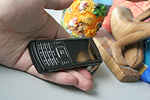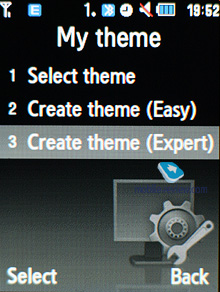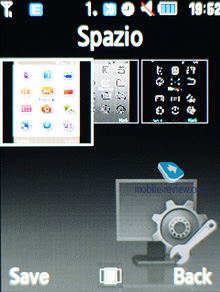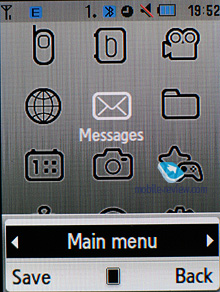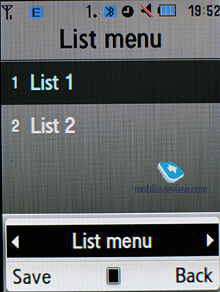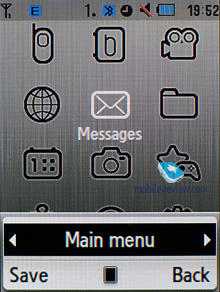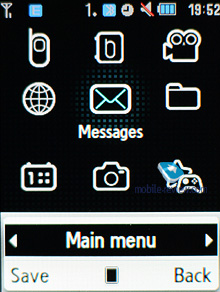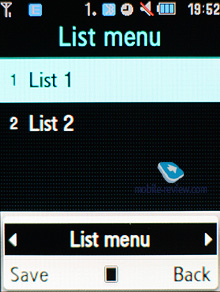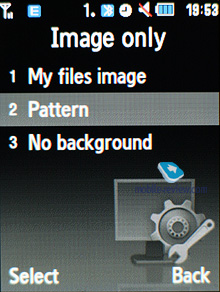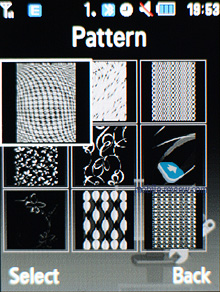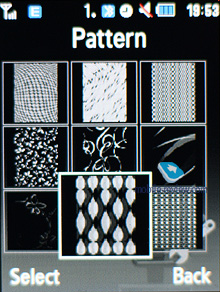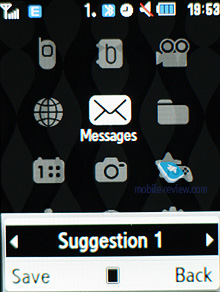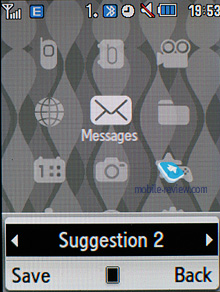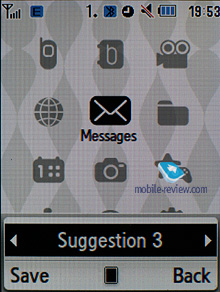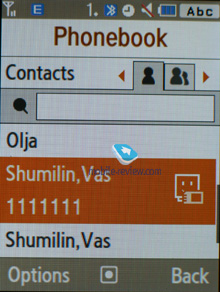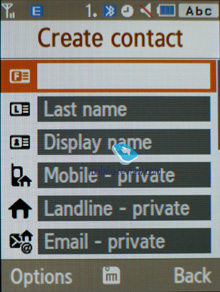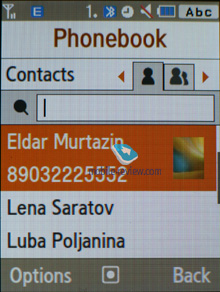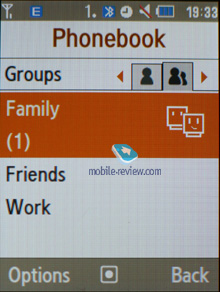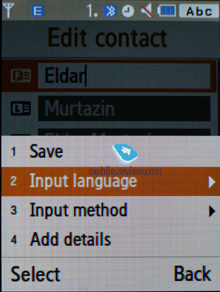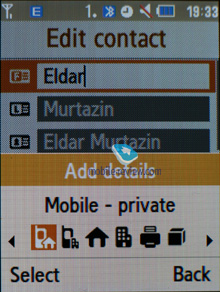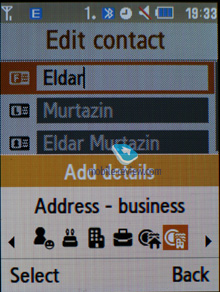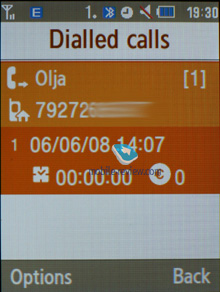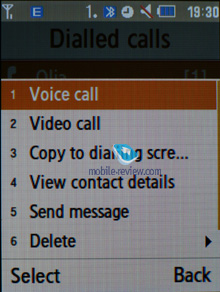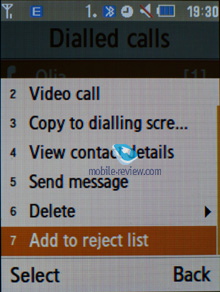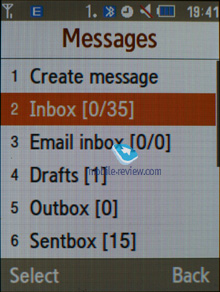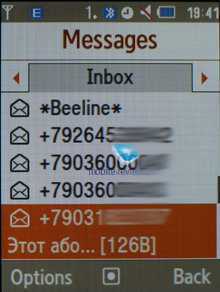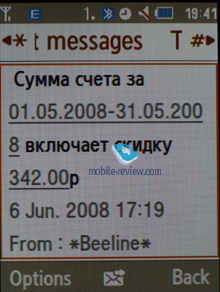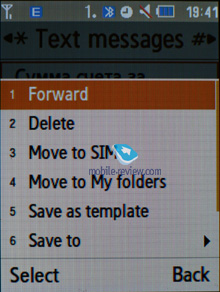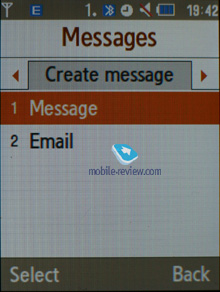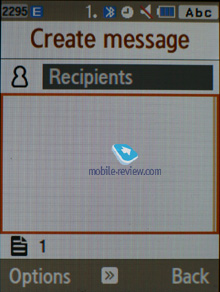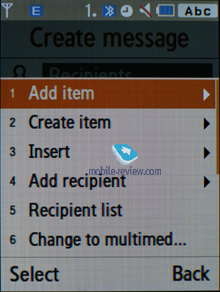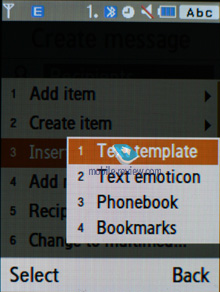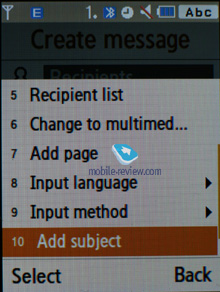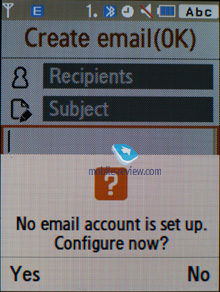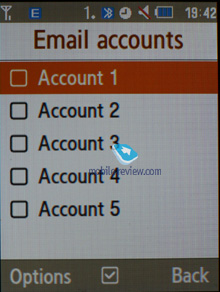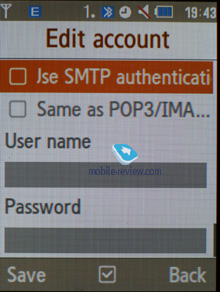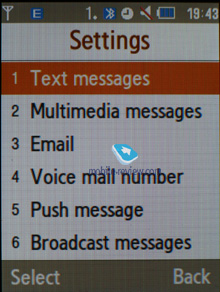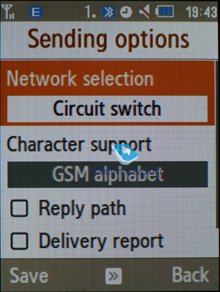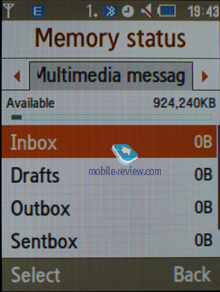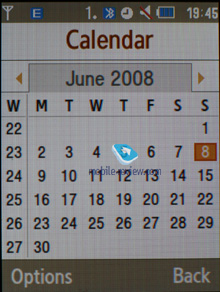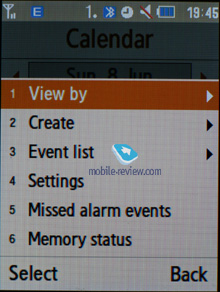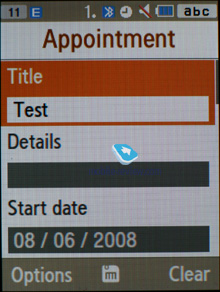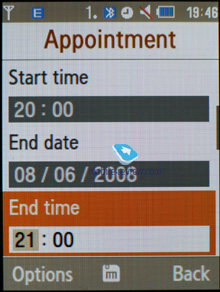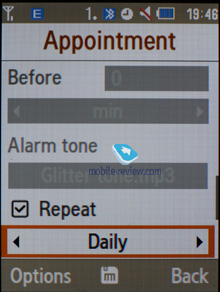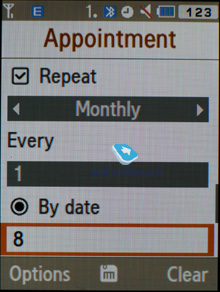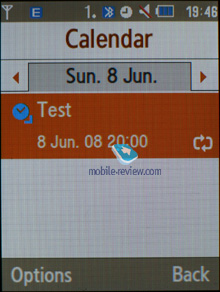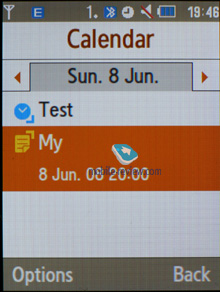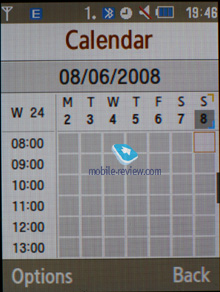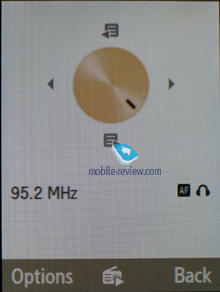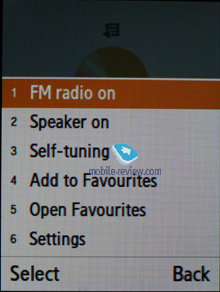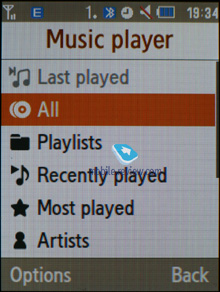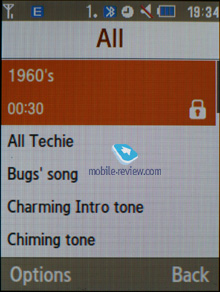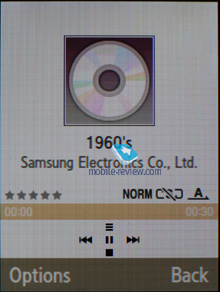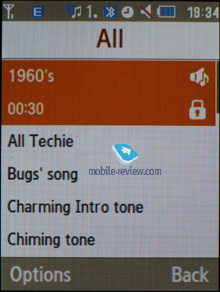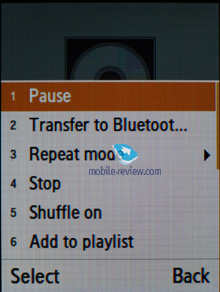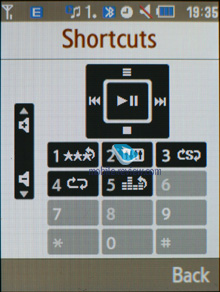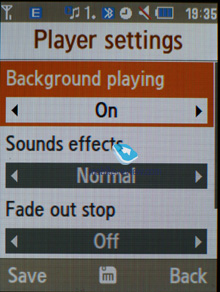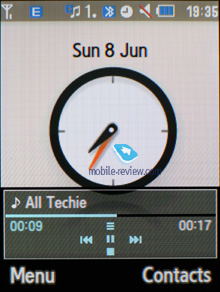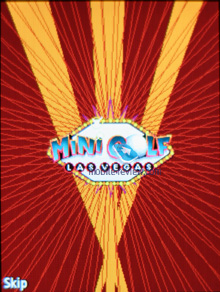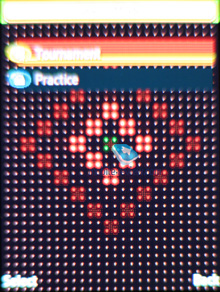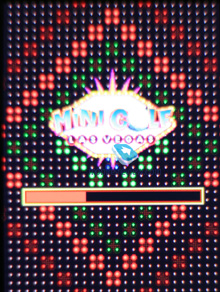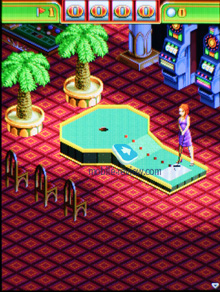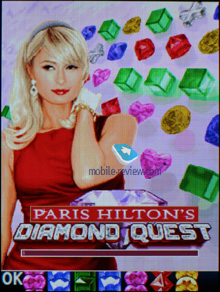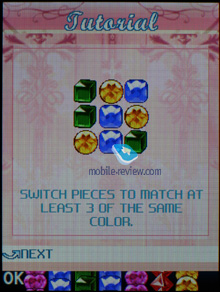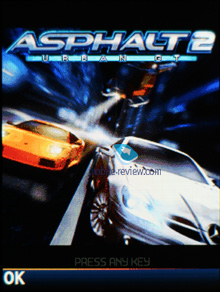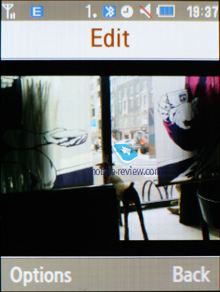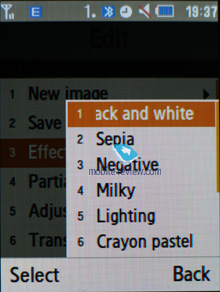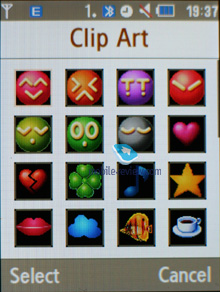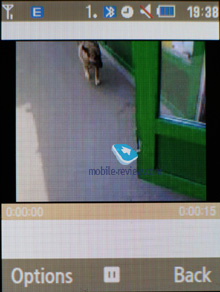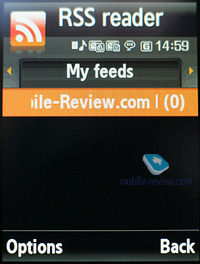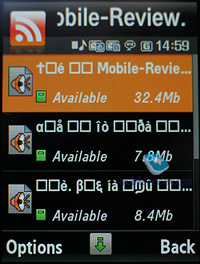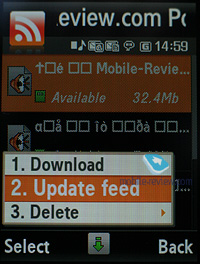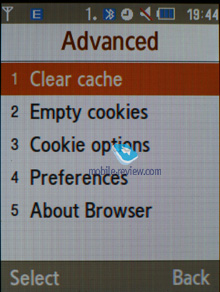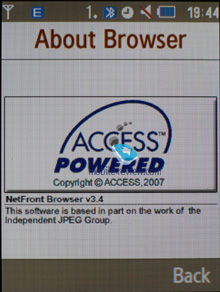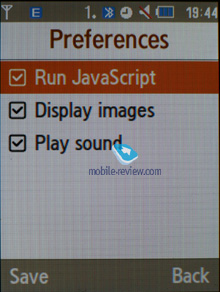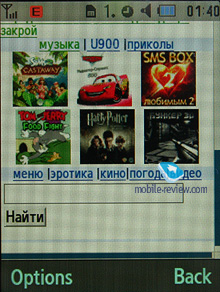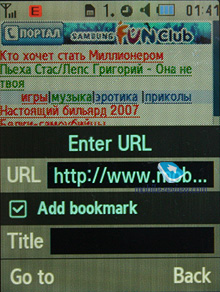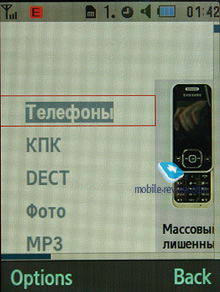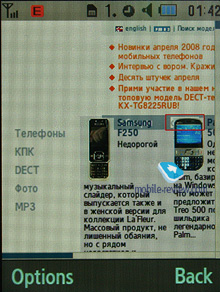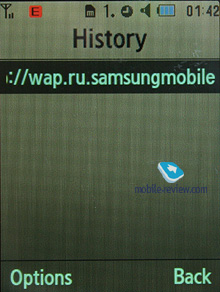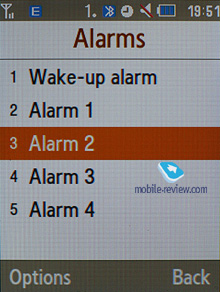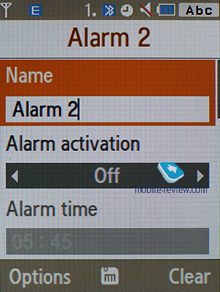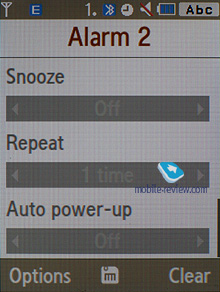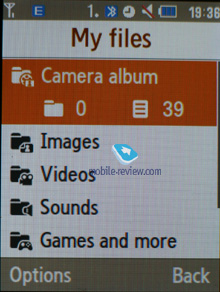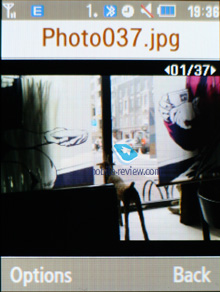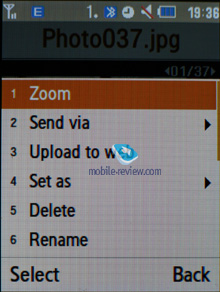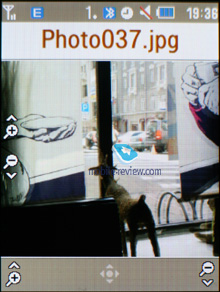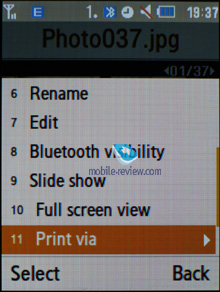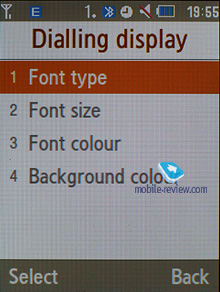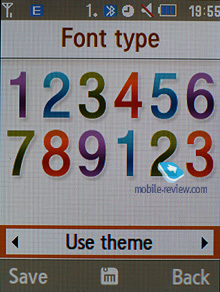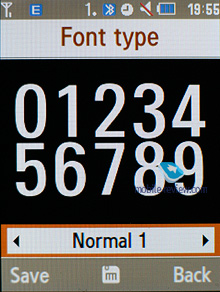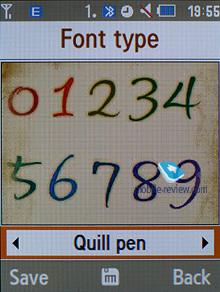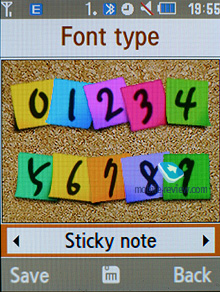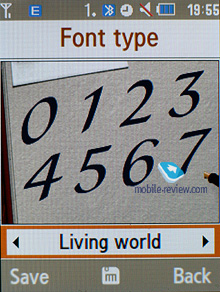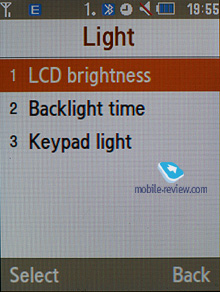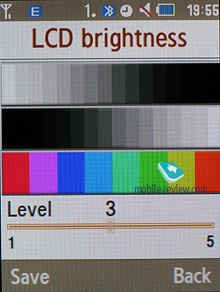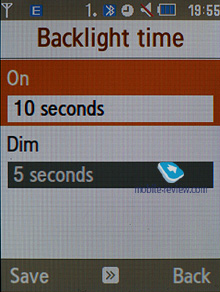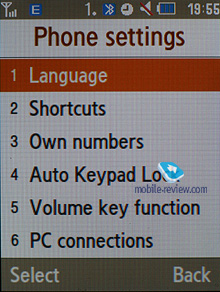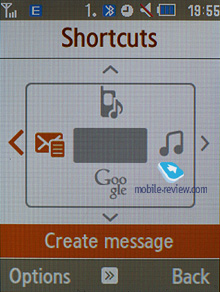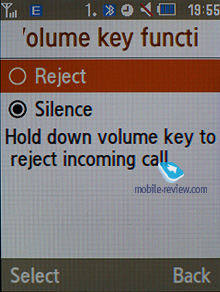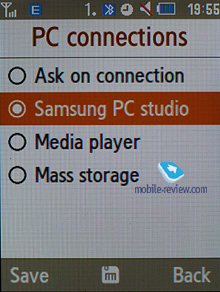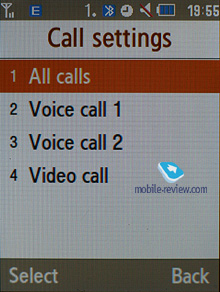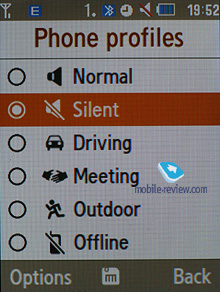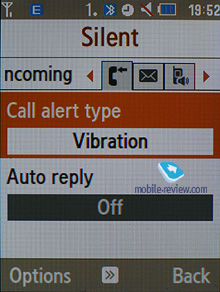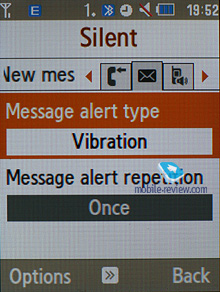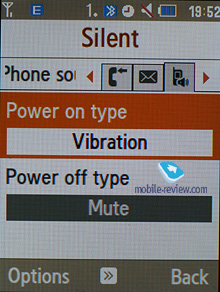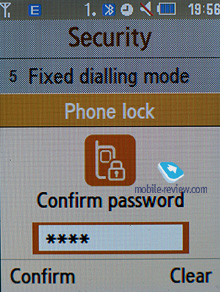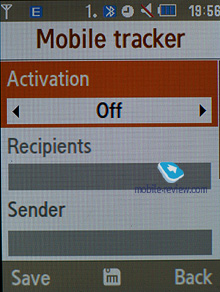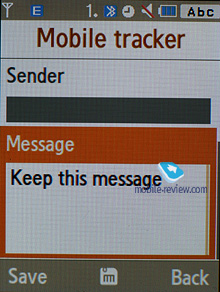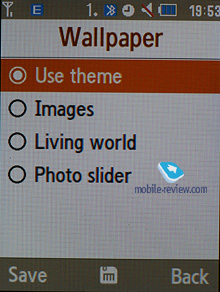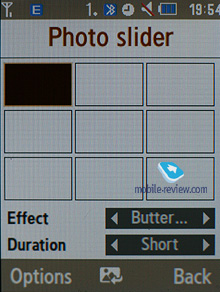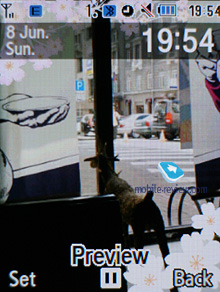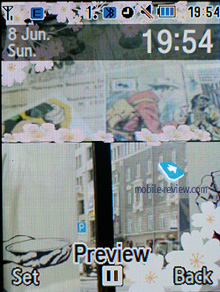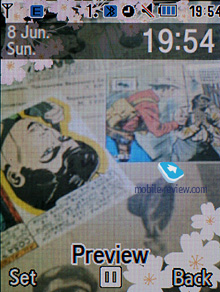|
|
Review of GSM/UMTS-handset Samsung U800 Soul
Live photos of Samsung U800 Soul
Table of contents:
- Positioning
- Design, size, controls
- Display
- Keypad
- Battery
- Connectivity
- Memory, Memory cards
- Performance
- Camera
- Menu, User interface
- Phonebook
- Call list
- Messaging
- Organizer
- Multimedia
- MP3-player
- Entertainment
- Applications
- WAP
- Alarm clock
- File Manager (My files)
- Settings
- Competition
- Impressions
Sales package:
- Handset
- Charger
- Wired stereo-headset
- Memory card (size and availability vary by region)
- User Guide
Positioning
The lot of this phone, and perhaps, the entire Soul (Spirit of Ultra) line-up inside Samsung’s framework is quite remarkable. Against the backdrop of the Ultra’s second generation, it was only fair to expect another range comprising of three phones, all in different form-factors, but it wasn’t the case with the Soul family. Although the Samsung G400 used to be in this camp, these days it’s an ordinary handset with no pedigree. So the only other device left is a candybar that was known as the U200 while it was in the works, but shortly before its announcement the maker thought that selling a lower-indexed solution wouldn’t make much sense, so they kicked it up almost to the level of the Samsung U900 Soul. And given their kindred software departments, they make for a nice duo – a slider and a candybar. Furthermore, if we discount the U900’s camera and touch-sensitive navigation pad, the U800 will turn out to be nothing but a copycat of the senior model packaged in a more conventional-looking casing.
Speaking of first Ultra-branded phones where “slim was in”, none of them were particularly popular. The Samsung X820 made a statement with its casing thickness, however its other feats and abilities were less stellar. The Samsung U100 turned heads with its wafer-thin profile again, but lacked a memory expansion slot, packing in what was considered a pretty decent camera back then. All in all, the best word to describe these two products was “nonsense”, since it’s wasn’t entirely clear what their target audience was and who would buy either of them intentionally. So, Samsung’s didn’t feel any lack of criticism in regard to these solutions and they tried to address all these complaints. How, I hear you ask?
They analyzed the problem. Their marketers tried to figure out what led the previous models to a failure and what other companies did to keep their phones afloat. Back when they tackled this matter the market was already filled with prototypes of the Nokia 6500 Classic (Nokia’s vision of this phone type) and the Sony Ericsson W880i was selling in droves. So, Samsung picked the W880i as the inception for their uber-handset and started thinking what extras they could tack on it to make their offering even more longed-for and fetching. The list they came up with was quite something and included all features of the Sony Ericsson W880i, padded with a couple of new ones. As a result, and that was a lucky coincidence, they rolled out a twin to the Sony Ericsson W890i on every single account. I asked people from Samsung about this curious fact and whether or not they really accounted for their rivals’ upcoming products every time they made something of their own. So far I’ve been getting the same answer: “It’s just a coincidence”. And somehow I believe them, because there is no such thing as spying in Samsung, a lot of things they present as “unparalleled” and created within their labs look pretty amusing and somehow familiar and always lag behind the market. They usually assess their impending offerings in relation to what’s currently available in the market and no wonder why Samsung-branded models always win by a huge margin there. It’s quite another matter, though, that in reality their offerings end up facing other solutions that they can’t stand up to. But we’ve already gone beyond the scope of this write-up, so it’s time we got back to the U800.

You will also come across numerous sources, where the Samsung U800 is referred to as the “Soul b”, where “b” stands for “bar type”, which doesn’t make a lot of sense. The thing is, I can’t imagine someone looking for the Soul b in some retail store, without knowing the phone’s index; perhaps in this case he or she won’t know what that “Soul” part has to do with the phone itself either!
But all this nonsense aside, the U800 is a fashion-savvy handset aimed primarily at 25-35 year olds, its target audience also includes all other age brackets except for teenagers. This is a device for people who value sturdiness and class and haven’t snatched a Nokia 6500 Classic, Nokia 6300, Sony Ericsson W890i or Sony Ericsson C902 yet. Some will say that I’ve gone mad and thrown too many phones on the U800’s list of rivals. But what can I do about it, since the main criteria when choosing a fashion-centric handset are price, brand and form-factor. This way, those who can’t stand Nokia’s or Sony Ericsson’s phones now have got a good alternative from Samsung, which is not without its own attractions.
Back to the table of contents >>>
Design, size, controls
For starters they will offer only one flavor for the U800 and that’s silver. But it’s not “silver” per se, it's more along the lines of “gun steel”. Obviously they will roll out other color swatches in the future – Samsung has always been generous in this matter.
Video. Looks, dimensions, menu (wmv, 33,6 mb) >>>

The U800 measures up at 111x46x9.9 mm and weighs 91 grams – all in all, it’s not a petite phone, but not a behemoth either. It won’t weigh you down, however it delivers a nice feeling of heaviness. Coupled with its metallic accents (that is, rear plate, front fascia and keypad) the U800 leaves an impression of a luxurious handset. Metal and weight are the two words that seem to make a compelling argument for a purchase for many consumers. Interestingly, compared to the Samsung U800 even the Sony Ericsson W890i feels like a lightweight, which doesn’t necessarily mean it’s bad, though.








But this feeling of robustness will get washed away over time and the reason for that is the flap on the charger slot. At first it seems there is nothing wrong with it, but a month into use it will no longer fit in the socket well. I didn’t feel like tearing it away, leaving the charger jack exposed, but with this flap on the U800 looked a bit goofy with a piece of plastic sticking out of the right-hand side.
Other than that I have no gripes with its build quality. Since the rear plate is lacquered it’s less of a scratch-magnet but you won’t be able to avoid them completely. The front fascia isn’t prone to fingerprints but surely can pick up some scratches and scuffs over time.


There is one thing I’m not fully satisfied with – once again, the display’s cover can’t deal with deep scratches. While occasional skin-deep scuffs won’t make any difference, anything bigger than that will cause a muddy spot to appear around that area. And don’t rub it, because you risk damaging the plastic layer (not the display itself), in which case the only way to get rid of it will be to polish the screen all over again, which is a pity. But, on the other hand, if treat your phone with care you probably won’t stumble upon this defect.


Perched on the left-hand side is the volume rocker. Hiding underneath a tight rubber flap is the microSD memory card slot. At the base of the U800 there is a lanyard eyelet. The red spot on the right is the dedicated camera button and topping the display is a forward-facing camera for videoconferencing, while the U800’s main 3 Mpix unit, along with a LED flash, is housed on the back.

Back to the table of contents >>>
Display
The handset makes use of a 2 inch TFT display (31x42 mm) with a resolution of 240x320 pixels showing up to 262 K colors (actually they claim it can handle up to 16 million colors, but the controller doesn’t support this many colors, just like in the Samsung U900; but in truth, you won’t see any difference anyway). This is a decent unit as far as color reproduction goes, although its tinted glass slightly roughens its colors. Indoors the U800 outputs a bright, juicy image; overall, it is one of the market’s best offerings to day. And outdoors we found that the U800's screen got washed out, was not as bright and occasionally we had to stare at it to read information.
The display accommodates up to 9 text and 3 service lines. All fonts are large and very readable; the same goes for SMS and dialing screen.
Back to the table of contents >>>
Keypad
The U800 utilizes a plain metallic slab for its numeric keypad, much like most other slim phones do. We were also pleased by how responsive and tactile the buttons were – for comparison, the Sony Ericsson C902’s buttons are conventionally-shaped, but at the same time are on the stiff side and thus are less comfortable to manage. All keys are lit in bright white, which is well-visible in various environments.




Back to the table of contents >>>
Battery
The handset utilizes a 800 mAh Li-Ion cell. The maker U800’s cell as being good for up to 230 hours of standby and 2.5 hours of talk time. Within European networks the phone lasted around 2.5 days (one hour of calls total and regular use of its alarm clock). At the same time, in Moscow it managed to stay online for 2 days at 1.5 hours of calls. That’s why the U800 will stay up and running for at least 2 days with average load, however under certain circumstances you might squeeze up to 3 days of operation out of it. It takes the handset 2 hours to charge from empty to full. No higher-capacity cells are available for this model.

We managed to get 10 hours of non-stop music from the U800 (radio module on) with the highest volume settings and bundled headset plugged in. Surprisingly, bar music time, the U800 scored the same as the Samsung U900 in all our battery tests, even though the U900’s battery is a bit more capacious.
Back to the table of contents >>>
Connectivity
Bluetooth. The model supports various profiles, such as Headset, Handsfree, Serial Port, Dial Up Networking, File Transfer, Object Push, Basic Printing, A2DP, Dual Profile Bluetooth. EDR-enabled Bluetooth 2.0 is onboard. Wireless headsets are handled by the U800 with ease.
USB-connection. In the menu you may select one of three modes: Media, Mass Storage, Samsung PC Studio. When connected to a PC via USB, the U800 automatically recharges itself.
While in the USB Mass Storage mode, the U800 shows up on the desktop without requiring you to install any additional drivers, so right after plugging in it’s ready to work. Data connection speeds top out at 950 Kb/s.
You won’t be able to use the U800’s Bluetooth connectivity along with USB – it will require you to disable Bluetooth regardless of its status (connected and transferring data or not), which is very awkward.
There is also EDGE class 10 connectivity for GSM networks.
Memory, Memory cards
The phone ships with 1 Gb of onboard memory – this storage space, give or take, is available to the user right out of the box. The memory card (hot-swappable) is displayed as a separate section, so you can’t access both memory types at a time. The U800 also comes with a file manager, enabling you to copy files to/from the memory card. In our test the handset had no problems handling a 8 Gb microSD memory card.
Back to the table of contents >>>
Performance
The U800’s performance is very typical as far as Samsung’s current device generation is concerned and is pretty modest, although, on the other hand, we could hardly demand more from a product of this class. As it stands today, new applications can be uploaded only over the air (wap). Java apps can’t exceed 300 Kb in size.
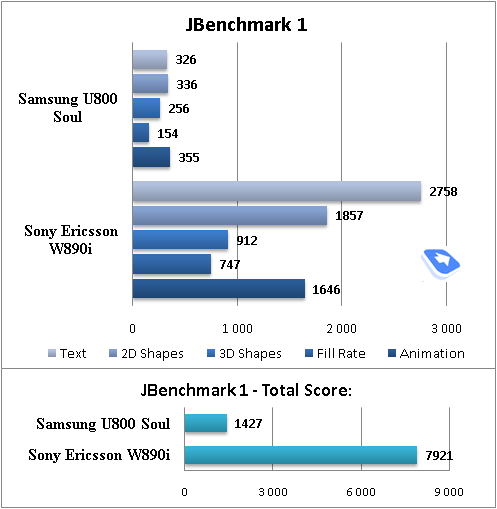
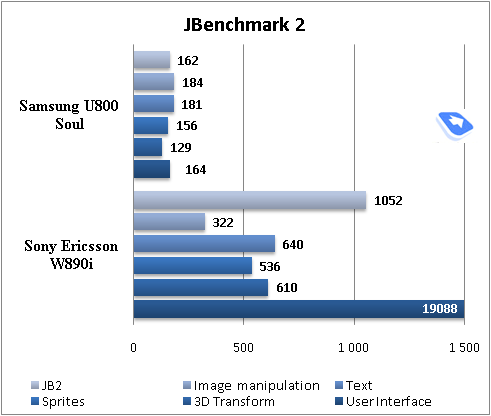
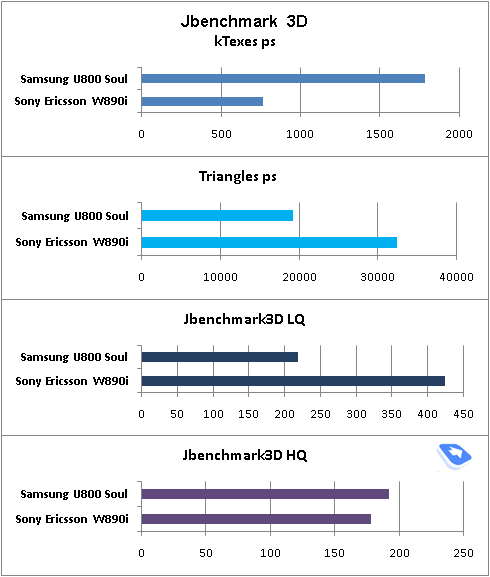
Back to the table of contents >>>
Camera
The handset utilizes a 3 Mpix CMOS module. The camera application enjoys the landscape layout, otherwise shooting with you would’ve been a pain. Various shortcuts pop up right on the navigation screen, including Macro Mode, Flash, Timer and Exposure. Since the numberpad is always exposed when shooting, you will be able to use the buttons over there as shortcuts too.

The camera supports the following resolutions:
- 2048x1536 (3M)
- 1600x1200 (2M)
- 1280x960 (1.3M)
- 640x480 (0.3M)
Several shooting modes are at your disposal:
- Single shot – default mode, the phone takes one shot at a time;
- Multi-shot – the phone takes a couple of shots in rapid succession (6, 9 or 15, two speeds, image resolution gets scaled down to VGA automatically);
- Mosaic shot – the U800 features a variety of mosaic shot types (image resolution gets scaled down to VGA automatically);
- Frame shot – while the resolution drops, you get access to the set of preinstalled frames;
- Panorama – the device can stitche together all parts of panorama on its own.
Other settings include special effects (Grey, Sepia, Negative, Water Colour) and timer (3, 5 or 10 seconds). The LED flash is not particularly bright, but it does the job. It is quite another matter, though that shots taken in the dark are far from decent, as the matrix obviously lacks sensitivity.
The U800’s camera is pretty average as far as its specs are concerned, but since it’s a music device we can’t really berate it much – we also were pretty content with the quality it provided on a sunny day.
 |
 |
| (+) maximize, 2048x1536, JPEG |
(+) maximize, 2048x1536, JPEG |
 |
 |
| (+) maximize, 2048x1536, JPEG |
(+) maximize, 2048x1536, JPEG |
 |
 |
| (+) maximize, 2048x1536, JPEG |
(+) maximize, 2048x1536, JPEG |
 |
 |
| (+) maximize, 2048x1536, JPEG |
(+) maximize, 2048x1536, JPEG |
 |
 |
| (+) maximize, 2048x1536, JPEG |
(+) maximize, 2048x1536, JPEG |
 |
 |
| (+) maximize, 2048x1536, JPEG |
(+) maximize, 2048x1536, JPEG |
 |
 |
| (+) maximize, 2048x1536, JPEG |
(+) maximize, 2048x1536, JPEG |
 |
 |
| (+) maximize, 2048x1536, JPEG |
(+) maximize, 2048x1536, JPEG |
 |
 |
| (+) maximize, 2048x1536, JPEG |
(+) maximize, 2048x1536, JPEG |
 |
 |
| (+) maximize, 2048x1536, JPEG |
(+) maximize, 2048x1536, JPEG |
 |
 |
| (+) maximize, 2048x1536, JPEG |
(+) maximize, 2048x1536, JPEG |
 |
 |
| (+) maximize, 2048x1536, JPEG |
(+) maximize, 2048x1536, JPEG |
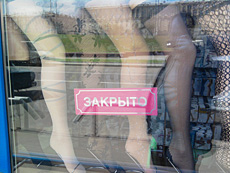 |
 |
| (+) maximize, 2048x1536, JPEG |
(+) maximize, 2048x1536, JPEG |
 |
 |
| (+) maximize, 2048x1536, JPEG |
(+) maximize, 2048x1536, JPEG |
Video. For videos the U800 proposes exactly the same pool of effects as for the single shot mode, plus most settings are identical, bar the resolutions, there is only one resolution available for video clips – 176x144 pixels (15 FPS). Maximum clip duration – up to 1 hour. Unfortunately, the U800 can’t shoot videos in VGA and in 176x144 it does its job at a very marginal frame rate.
Back to the table of contents >>>
Menu, User interface
The U800’s main menu is shown as a 3x4 grid with all sub-menus enjoying horizontally-arranged lists; but you can’t see sub-menus in the same list like with the Samsung U900. While surfing the menus you can take advantage of last item memorization in every sub-menu and the main menu. The handset will “remember” which function you addressed last time, and will highlight it automatically next time you enter the same menu item. For example, if you had selected call list in main menu and done some operations in it, then the next time you enter main menu you will have it highlighted in first place. But that’s not all; once you access it again you will see that sub-menu item which was addressed last will be highlighted too. When hovering over one or another item in the list you will see it highlighted, and the font size - increased.
Shortcut number navigation is supported, but there are more ways to navigate the menu in the U800. You can bind four different applications from the list, offered by manufacturer (you will not be able to bind java applications). There is no quick launch menu available in the U800 (uMenu).
Themes. The U800 comes preinstalled with 3 themes, the default one meshes with the handset’s metallic details. Additionally the user can make used of the themes editor (available modes: basic and extended). In the former mode all you need to do is pick new wallpaper, tune some settings and voila, you have a new theme. But in the latter case, you will have the ability to adjust and modify every last thing, from icons color to fonts in specific menus, plus you get tips on how to make things look better in your personal theme.
Living World. This is a selection of personal wallpapers for each country (major cities might get unique wallpapers in the future, though it is not quite evident). When you will be in Moscow you will see Kremlin wharf and triumphal arch in case you’re in Paris, as for London – house of parliaments, and so on. Besides graphical assignation manufacturer decided to modify wallpaper depending on time of day: in the morning you see sun, and in the evening you see blinding lights of Kremlin wharf, cars will have their headlights turned on.
Time is not the only event that can be morphed into graphics. For example network reception level: good signal – sky is blue, no signal or weak one – sky is covered with clouds. At first you don’t pay much attention to this tiny feature, but after a month you will look on the sky instead of the standard bar.
For new messages, missed events, or alarm clocks there is a special way of displaying, and which is powered with standard, traditional pop-up window with text. In daytime, such events will be demonstrated with help of airplane that will fly through the sky, and in the evening that would be fireworks. Color will change according to event type. At a glance this system looks kind of complicated, especially during its description, but in reality it is crystal clear and understandable.
When dialing a number you will see a small image with main theme displayed and animation of the dialed number.
Back to the table of contents >>>
Phonebook
Contacts can be accessed by pressing right soft key; you will see a list that contains all entries from both SIM-card and phone’s memory. The second tab comprises contact groups, so that you can switch to them in no time. If there is an assigned image, its thumbnail will be shown in the list – when scrolling though your contact list, a thumbnail will be shown only for a currently selected entry, and if there is none set, the U800 will use a default smilie.
The field beneath the name is the default number, which can be picked manually from the list of submitted numbers for a particular contact. Quick name search by first letters is supported; there can be up to twenty of those, for any language. Once you press OK key you will go into detailed view of the selected entry. There you will see a thumbnail, if any. It can be an image, a photo or a video clip. Each entry can have up to 5 phone numbers of different types (mobile, office, home, fax other), one of them will be main number (by default it is the first one you entered). Fiels aren’t fixed, meaning that you can choose their type manually (for example, submit two mobile and two home numbers for some contact).
There are two lines for First Name and Last Name (search is performed only by the former), these fields get merged when displayed in the general list, and First Name comes first. For example Eldar Murtazin will be shown only in this order. Length of each field is 20 characters for any supported input language. You can also switch languages on the fly when entering a name.
All entries, regardless of language, are sorted out in the following way – all contacts with headings made in a local language (Russian, for example) go first and then those with names in English. This is rather convenient and handy list sorting system. Taking into account fast language switch option during the search, it’s clear that no language will spoil the experience of working with this phone. The list can be sorted by first or last name.
But let us return to the information entered for a contact. Apart from phone numbers, e-mail address (there may be several of them), a little text memo, address and other fields can be submitted on top of all that. Any music file (including MP3) can be picked as a ring tone for a contact. Three caller groups are provided by default with the possibility for creating any number of additional groups, setting a personal melody and image for each (by default there are three groups). SMS alerts are not customizable.
The phonebook is capable of holding up to 1000 contacts with filled in data fields. Even if all the available blanks are not used, the cap won’t get any bigger and will still make one thousand. It is possible to specify in the settings where all new numbers should be kept by default. There is also an option for moving entries from the SIM-card, although the reverse action is denied. According to the developers, PC (MS Outlook in particular) is best for data synchronization with the U800. Any contact in the form of SMS/MMS, mail message or other text file can be quickly sent through Bluetooth to another device. There are no problems with sending, and the phonebook entry gets beamed to another device, where it is read without any trouble.
The phonebook may contain a business card as well, though its structure copies all the fields found in a regular contact in the phone book.
There can be up to eight numbers in the fast dial list; separate numbers tied up with a single contact may appear on this list as well. The chosen entry (not of the phone number type) is displayed on the buttons as the subtitle. In case the contact you have picked has an image attached to it, then you won’t see the entry’s name, which may get annoying when you have two different numbers of one contact mapped.
You can create any number of caller groups, assign up to 20 contacts and customize them with a picture and tune.
On an incoming call, caller ID picture occupies not the entire screen, but only a part of it. However, it still takes up a considerable area. This isn’t great, given the display’s stellar specifications.
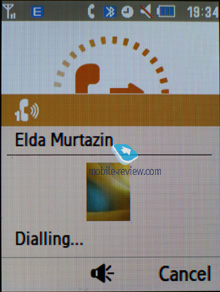
Back to the table of contents >>>
Call list
Each of the given lists contains up to 30 phone numbers. There is a combined list of all the last calls with an icon indicating call type. Pressing the navi-pad horizontally, you can switch quickly between the lists. The date and time of the calls with a special note on duration are displayed in the extended view for separate entries. Calls from/to one number are grouped up, so that the number standing next to the call specifies total number of calls made. In order to access duration data you will need to call up detailed information on desired item. As always, the overall time of the calls and their cost can be viewed in this menu (in the case that the service has been enabled).
For individual numbers you can arrange a black list, which will reject all calls coming from these contacts.
Back to the table of contents >>>
Messaging
Much like other makers, over at Samsung they have forgone that artificial division into SMS-MMS types – you just start composing a message, and only then, depending on the contents, it is attributed to SMS or MMS. The menu still holds an option for switching message into MMS mode (for example when you need to send only text, but to an e-mail address, without calling up the bundled client).
The phone memory can hold up to as many as 500 messages; the handset supports EMS standard compatible with Nokia Smart Messaging. T9 text input comes in handy and is easy to use. While choosing recipient, you can either select a telephone number from your contacts or pick one from the call lists or groups. All messages are manageable, this means you are at liberty to move a certain number to your black list, in order to make sure all messages coming from that phone number will be deleted automatically; possibility for moving messages to any own folder is also at your disposal. For e-mail you can move not only addresses to the blacklist, but unwanted subjects as well.
There are no size restrictions set on received messages, though an outgoing message’s size is limited to 295 KB. As for additional services available with the U800, message rejection and message retrieval type options are onboard. All messages are stored in general dynamic memory, the same goes for e-mails.
Also there is a useful function for sending SOS-messages – when activated, should you find yourself in an emergency, after pressing the volume key four times, the message «I am in emergency. Please help me» will be sent to contacts submitted earlier, all incoming calls from these numbers upon sending the emergency message will be picked up automatically. Recipients (not more than 5), as well as number of Repeats may be set up manually, while text of the SOS-message is not customizable.
The bundled mail client is standard in all its components – 5 accounts and the maximum of 100 incoming messages; attachments are also handled by the phone, though there are also several caps – there’s no way you can receive a file more than 500 Kb big, or send one with size exceeding 300 kb. Received files can be viewed via the bundled browser. The U800 doesn't support html in emails, which breaks formatting of most letters you receive, so they become really awkward to read. The mail client found in Samsung-branded phones is now falling behind those embedded in Nokia’s and Sony Ericsson’s solutions.
Back to the table of contents >>>
Organizer
The phone’s memory can store as many as 100 events of one type – meeting. There are other event types as well, like anniversary and holiday, with the maximum capability of 50 events for each type. The U800 can also hold up to 20 high-priority events and the same number of private entries.
Day and time as well as end time of an event are indicated for each entry. Alert signal and its duration can be adjusted to your liking; repeatable events are available for setting up (repeat time is also manageable as well as the exceptions). The weekly and the monthly calendar views are very convenient with each type of the event having its own color.
Speaking of the organizer’s shortcomings, I cannot overlook the fact that when typing date and time for an event, the end time doesn’t change, which badly hurts its ease of use – other manufacturers make the due time shift automatically (by default any event takes one hour).
Back to the table of contents >>>
Multimedia
FM-radio. You can store up to 50 radio stations in the memory; the range of available frequencies is 87.5-108 MHz. Also, you can enjoy auto-tuning, but particular channels cannot have own names attached – they are always shown as the frequency numbers. The radio can work in handsfree mode, plus it enables you to set it up as an alarm clock, but regardless of how you are going to use it, a plugged-in headset is a must, since it doubles as an antenna. The radio implementation is fine, although it doesn’t pick up all stations equally well, but on balance, it is quite competent in comparison to other vendors’ offerings. The radio can be minimized.
RDS here displays only the station’s name in the general list, no advanced options available.
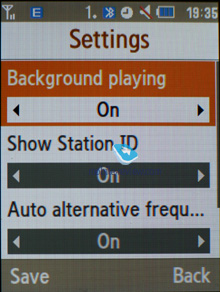
Voice recorder. You can record up to several hours of voice memos with the number of files being unlimited. Basically, limitations on recording duration are set by the user himself, though length of a single recording cannot exceed 1 hour. All the files are stored in a separate folder in the memory bank. The recorder performs well during lectures, conferences and presentations – I could even say that it is a partial substitute for a digital tape recorder.
Back to the table of contents >>>
MP3-player
The integrated mp3 player, supporting random, sequential and cyclic playback, is available on the phone. Mp3 files can be uploaded onto the handset both directly over Bluetooth and through the synch application or Windows Media Player. There are no limitations placed on tags and names of music files. Bitrates are also not something that really matters – the handset easily deals with all available formats and supports WMA, AAC, eAAC, eAAC+.
The title of the currently played back track is displayed as well as the number of the remaining tracks. The U800 also packs in a non-adjustable equalizer with 9 presets available. Among new additions is the Fade Out option, when towards the end of every track the sound will… well, fade out. Your tracks can be played through the stereo headset as well as the speakerphone. The volume bar has 14 scales on it. And of course the user can make up their own playlists. Player can work in minimized mode – in this case the display will show current track title and music controls, which is a good thing.
The player boasts the following filters: all tracks, recently players, most popular, artists, albums, genres and composers. The U800 also sports Album Arts support.
Speaking of new options, the player has obtained the rating system, enabling you to award any track with one to five stars. The maker has driven the integration with Windows Media Player as deep as it has never been before; actually, this manager also sports the rating system.
The bundled headset has a jack for plugging in own earphones and provides quite adequate sonic experience. Generally speaking, as a music-minded solution, the U800 comes close to Sony Ericsson’s Walkman range, especially as far as the first generation is concerned. Plus it holds its own against contemporary music-heavy phones, the U800’s sound quality is pretty decent, and it can well replace a dedicated device, especially if you are not an audiophile or tend to have music sessions in noisy environments.
Back to the table of contents >>>
Entertainment
Games – the handset comes preinstalled with three games, which are all demos (you will have to shell out for their full versions), these are: Aspalt2, Minigolf Las Vegas, Paris Hilton Diamond Quest. There is an unlimited amount of memory assigned to Java-applications, plus you can remove any of the pre-installed games and upload new over the air (via WAP). Heap size can’t exceed 2 Mb, while the application can’t go over 1 Mb.
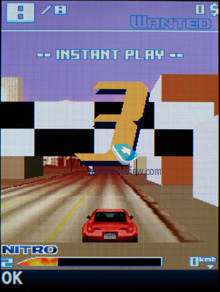
Image editor. A basic picture editor, which allows transforming images by using a variety of tools.
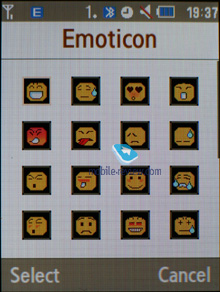
Video editor. Allows editing video clips and overlaying of sound tracks. The most basic of editors makes its first appearance with the U800.
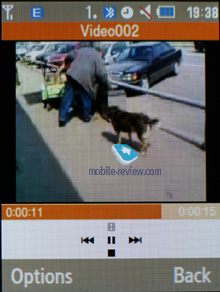
Back to the table of contents >>>
Applications
World time is displayed for two chosen cities.
Calculator It divides, multiplies, subtracts and adds and does several more things – quite enough for a mobile calculator.
With the converter, you can operate with different units of measurements as well as with a number of currencies.
Countdown time and stopwatch have no bells and whistles.
Memo – standard text notes.
RSS Reader. This is a stand-alone utility for RSS feeds. However, it would make more sense if the RSS Reader was bound up with the web-browser, but this is not the case with the U800. This way, RSS links are not picked up by the browser, or sent directly to the application. You will need to manually submit a channel address in this app to subscribe, or enter a web address and let the application try to find an RSS channel on it.
While uploading your news feed, the U800 can upload text, as well as video and audio files, and it is up to you to set the size limit (by default – 5 Mb per file). Regrettably, there are no scheduled feed updates available, thus you will need to refresh the feed manually every time you need hot news.
Obviously with this application Samsung is having a first go at this field, and the truth is, it is not really functional or appealing the way it is in the U800. Similar solutions found in the phone from other makers pack more punch and are easier to manage.
Google. A stand-alone menu item for accessing Google search and GMail. Generally, the same things are available with handsets from other manufacturers, except for a dedicated menu item. In my judgement, this is nothing more but a marketing trick, however I can’t see anyone shouting “I have Google in my phone!” Who might find this feature essential in a phone?!
Back to the table of contents >>>
WAP
The handset comes with a wap-browser version 2.0 (NetFront 3.4), where apart from JavaScript support, fonts scaling (three types), Smart-Fit (single-column view), full-screen mode (all controls are hidden), page caching, they have embedded a new feature – on-screen ‘mouse’ pointer. Much like Nokia’s S60-powered handsets and Opera Mini, you can view pages with a tiny navigation window displayed. The browser itself packs a lot of goods under the hood and will be appreciated by most users.
Unlike the previous models, which used Picsel Viewer for browsing office documents, the U800 employs the bundled browser for these purposes. What we really like about it is that the user can perform local search within a document (any language). While it is a tad sluggish compared to Picsel Viewer, it is still pretty easy to handle. Personally, I couldn’t make up my mind on which solution I liked better – both of them have their strengths and weaknesses.
Back to the table of contents >>>
Alarm clock
The handset comes equipped with four alarm clocks, each of them can go off on certain weekdays. You can also pick one of the five tunes, or turn to MP3 tracks. In settings it is possible to enable auto power-up when any event triggers.
Back to the table of contents >>>
File Manager (My files)
That’s the place to search for all files such as music, pictures, video and sounds. Any uploaded file gets stored here. The disadvantage is that files sometimes are not displayed in the list immediately - in that case you will need to leave the menu and enter it again.
Files and folders can be viewed either as a list or thumbnails. You can mark any number of files. The handset supports Move, Copy and Delete operations, as well as various types of sorting (by type, name or size).
Memory card’s file structure is a slightly different story, as it can be accessed through the main menu, where each item features “Memory card” option.
The U800’s new feature is support for ShoZu that allows uploading any type of multimedia content to blogs – all it requires you to do is submit your logins and passwords to the services you use and then the handset will do the rest, enabling you to release, say, videos or photos right to you personal blog.
Back to the table of contents >>>
Settings
Traditionally this item boasts a standard set of options inside like password protection of selected sections (messages, short messages, organizer, etc.), backlighting duration and brightness, dialing display settings (no custom animations are available, one is assigned to the default theme – Living World).
Keypad light – there are three options at your disposal, one of them is Night mode, implying that backlighting will be active only between 5:00 PM and 9:00 AM and disabled during daytime. If you come to think of it, this feature is nothing more but an illusive replacement for ambient light indicator, which Motorola’s handsets are armed with.
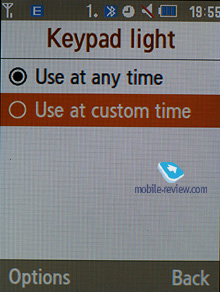
Profiles – the U800 comes with a fully functional system of profiles, including Flight Mode. Every profile is customizable – you can pick ring tone, incoming message alert and adjust the volume level.
Mobile Tracker – submit a phone number, where notifications will be sent to in case SIM-card was changed – that message will contain number of the SIM-card being used with the handset. This section is protected with password, so that no one other than you or someone else who knows the password could disable the Tracker. Should your device have the SIM-card switched once, the specified number will receive one message instantly, and one more each time a new card is plugged in. A fetching feature which can prove to be of much help in case the handset is lost or stolen.
Apart from the standard set of wallpapers for the standby screen, you can make up animated wallpapers of your own, and it doesn’t take a rocket scientist to create one. All you need are 9 snaps, then you adjust time spans between different frames and transition effects (there is a slew of them available, like Butterfly, Paper place etc). And the animation you get is pretty amusing; it will work on the standby screen as long as the display is on.
Back to the table of contents >>>
Competition
Like we already said, the U800 is a fashion-savvy device that goes up against a couple of other solutions, but we have no intentions of going over all other of them here, since in this segment the problem of choice comes down to personal preferences, such as brand and design. At the same time, since the U800 matches the Sony Ericsson W890i on most major accounts, we though it’d be fair to put them up against one another.
| |
Samsung U800 Soul |
Sony Ericsson W890i |
| Size and weight (mm, grams) |
111x46x9.9, 91 |
104x46.5x9.9, 78
|
| Display |
QVGA, 2 inches, 16 million colors |
QVGA, 2 inches, 262000 colors
|
| Memory, Memory cards |
1 Gb, microSD memory cards up to 8Gb |
36 Mb, memory cards up to 8Gb |
| Camera |
3 Mpix |
3 Mpix |
| Bluetooth |
Yes, 2.0 + EDR |
Yes, 2.0 + EDR |
| Battery
|
800 mAh, Li-Ion
|
950 mAh, Li-Pol
|
| FM-radio |
Yes |
Yes |
| Price |
350 Euro |
350 Euro |


With their identical price tags, the U800 has only one trump up its sleeve – more memory onboard, which is, however, negated by the M2 memory card coming packaged with the W890i. That said, most of their differences come down to philosophy and software – while A200 is more powerful, many features are well-implemented in Samsung’s platform too. Furthermore, as far as core functionality goes (messaging, phonebook), neither handset holds the upper hand.
Back to the table of contents >>>
Impressions
The reception quality put up by the U800 is in line with other Samsung-branded devices. The ringtone volume is quite decent, as it can be heard in various environments. The silent alert is average strength-wise, no significant improvements have been made here, but compared to the U900, the new U800 is a wee bit louder.
The U800 is a well-rounded and well-balanced phone – it feels comfortable in the hand, packs in quite a bit of features and boasts a dazzling display. It doesn’t have any striking failings, bar the possibility of the display surface wearing out over time (but all you need is a pinch of care for your phone and this should do it). And it’s up to you what to think of its design – some like handsets more along the lines of Sony Ericsson W880i, some prefer the U800, Motorola L9 and the likes.
At 350 Euro the U800 is a fairly great fashion-savvy offering that will generate sales at least on a par with the Sony Ericsson W890i, for these two are pretty much in one league. If you are in the market for a svelte handset for calls and probably some music, then the U800 should definitely be on your short-list.
Related links:
Back to the table of contents >>>
Eldar Murtazin ([email protected])
Translated by Oleg Kononosov ([email protected])
Published — 05 July 2008
Have something to add?! Write us... [email protected]
|
News:
[ 31-07 16:21 ]Sir Jony Ive: Apple Isn't In It For The Money
[ 31-07 13:34 ]Video: Nokia Designer Interviews
[ 31-07 13:10 ]RIM To Layoff 3,000 More Employees
[ 30-07 20:59 ]Video: iPhone 5 Housing Shown Off
[ 30-07 19:12 ]Android Fortunes Decline In U.S.
[ 25-07 16:18 ]Why Apple Is Suing Samsung?
[ 25-07 15:53 ]A Few Choice Quotes About Apple ... By Samsung
[ 23-07 20:25 ]Russian iOS Hacker Calls It A Day
[ 23-07 17:40 ]Video: It's Still Not Out, But Galaxy Note 10.1 Gets An Ad
[ 19-07 19:10 ]Another Loss For Nokia: $1 Billion Down In Q2
[ 19-07 17:22 ]British Judge Orders Apple To Run Ads Saying Samsung Did Not Copy Them
[ 19-07 16:57 ]iPhone 5 To Feature Nano-SIM Cards
[ 18-07 14:20 ]What The iPad Could Have Looked Like ...
[ 18-07 13:25 ]App Store Hack Is Still Going Strong Despite Apple's Best Efforts
[ 13-07 12:34 ]Infographic: The (Hypothetical) Sale Of RIM
[ 13-07 11:10 ]Video: iPhone Hacker Makes In-App Purchases Free
[ 12-07 19:50 ]iPhone 5 Images Leak Again
[ 12-07 17:51 ]Android Takes 50%+ Of U.S. And Europe
[ 11-07 16:02 ]Apple Involved In 60% Of Patent Suits
[ 11-07 13:14 ]Video: Kindle Fire Gets A Jelly Bean
Subscribe
|
